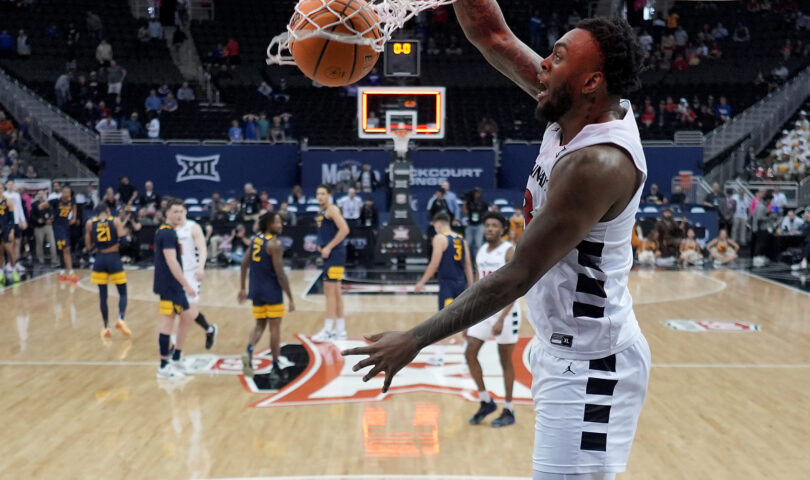OK, so now what?
The moment Cincinnati completed their come-from-behind 90-85 victory over West Virginia on Tuesday in the Big 12 tournament, WVU athletic director Wren Baker went on the clock.
That much was obvious.
Baker will be looking for a new WVU coach, again, obviously.
He’s had, at the very least, a little more than four months to compile a list of names. He technically went through a search last June, after former coach Bob Huggins resigned, so Baker isn’t exactly going into this search uninformed.
Many replacements have already been thrown out there on message boards and social media.
The general consensus is pointing at Florida Atlantic coach Dusty May, but May will be a top candidate at a lot of places, including Ohio State, maybe Indiana.
You’re also going to hear James Madison coach Mark Byington’s name a lot. He knows the area — he was born in Salem, Va. and was an assistant at both Virginia and Virginia Tech — and Byington is a hot commodity right now after leading the Dukes to 30 wins and the NCAA tournament.
Let’s move past the coaches for now, though, and talk about the other factors in the future of the WVU program.
For starters, let it be known that all that NIL money that was thrown around last summer to secure a highly-ranked transfer portal class probably won’t continue to be there.
The majority — if not all — of that money that helped sign guys like Kerr Kriisa, RaeQuan Battle and Jesse Edwards came from boosters entrenched in Huggins’ camp.
It was seen as a one-time effort to help get Huggins and WVU to the promised land.
Instead, those boosters likely ended up shelling out — and this is purely a guess on our part — somewhere between $200,000-$300,000 per win, which should be a huge embarrassment on their part, not to mention the worst misuse of funds since Enron.
No, we don’t need better roads or hospitals. The homeless don’t need shelter, but, by God, West Virginia needed a power forward, so here’s a check.
Anyway, it’s highly unlikely — unless Baker is able to get Roy Williams or Jay Wright out of retirement (not going to happen) — that those same boosters are going to fork over that kind of cash again.
Which leads us to the other main factor to this offseason: There are going to be plenty of holes to fill.
Going by the previous NCAA transfer rules, which may not even exist anymore following Battle’s federal court case against the NCAA a couple of months back, we believe Noah Farrakhan and Jeremiah Bembry are the only two players on the roster who aren’t eligible to transfer and be immediately eligible somewhere else.
Quinn Slazinski could be added here, too. He is looking into petitioning the NCAA for a sixth year of eligibility, due to the injuries that cost him most of last season at Iona, but there’s no guarantee he’ll be granted that year.
Let’s be honest here, too, after the pile of dung that was thrown at the NCAA over Battle’s eligibility, the NCAA probably isn’t looking to do WVU any favors.
Now, we’re not suggesting there’s going to be a mass exodus of players, but we also wouldn’t be surprised if there was one before we get to the end of this sentence.
So, you’re going to need a new coach, most likely a new roster and not have nearly as much in NIL funds that were proudly flashed around last summer.
And, by the way, you need all of that while competing in the Big 12, which you may have heard is pretty good.
Let me save you the suspense of waiting six months for next season’s Big 12 poll to come out: The Mountaineers will be picked last in what will then be a 16-team league.
“It’s been a challenging year,” WVU interim head coach Josh Eilert said Tuesday, in what may be his final press conference.
If you thought this was a lost season — WVU set a record with 23 losses — next season isn’t going to be any better.
Eilert’s contract runs out on April 30. It’s likely Baker will have someone new in place by then.
It better be someone who can teach a little toughness and defense, because the Mountaineers had little of either this season.
For a second consecutive game, Cincinnati put up at least 90 points on the Mountaineers.
The Bearcats hit 16 3-pointers.
All of it became too common a factor as this season wore on.
Everyone scored a lot against WVU, which allowed nearly 77 points a game this season.
In the end, Eilert compared the season to a roller coaster, and here is the one suggestion we have for Baker in his coaching search:
Find someone to simply bring that roller-coaster ride to an end.
From a PR standpoint, the men’s hoops program has already been drug through the mud enough with the Huggins’ saga over the summer, and then a dismal season on top of that.
Forget about wins and losses for a moment and find stability, someone who can get through an offseason without horrible headlines and losing five or six guys to the portal every year.
That, in itself, would be a nice win for the Mountaineers.
Lord knows they didn’t have many of them this season.




